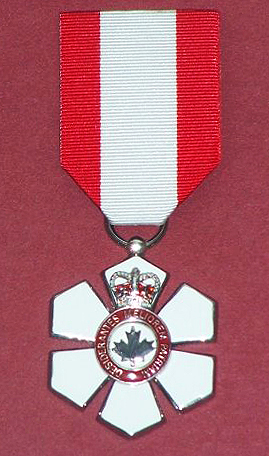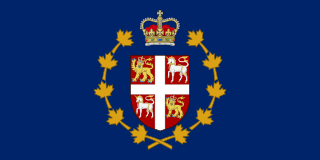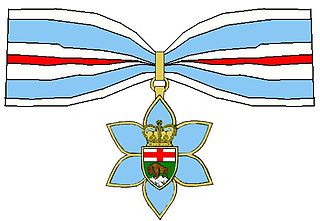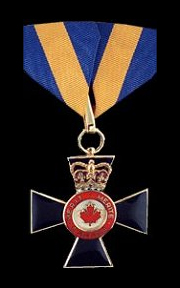
The Order of Canada is a Canadian state order and the second-highest honour for merit in the system of orders, decorations, and medals of Canada, after the Order of Merit.

The Order of Ontario is the most prestigious official honour in the Canadian province of Ontario. Instituted in 1986 by Lieutenant Governor Lincoln Alexander, on the advice of the Cabinet under Premier David Peterson, the civilian order is administered by the Lieutenant Governor-in-Council and is intended to honour current or former Ontario residents for conspicuous achievements in any field.

The Order of British Columbia is a civilian honour for merit in the Canadian province of British Columbia. Instituted in 1989 by Lieutenant Governor David Lam, on the advice of the Cabinet under Premier Bill Vander Zalm, the order is administered by the Governor-in-Council and is intended to honour current or former British Columbia residents for conspicuous achievements in any field, being thus described as the highest honour amongst all others conferred by the British Columbia Crown.

The National Order of Quebec, termed officially in French as l'Ordre national du Québec, and in English abbreviation as the Order of Quebec, is an order of merit in the Canadian province of Quebec. Instituted in 1984 when Lieutenant Governor Jean-Pierre Côté granted royal assent to the Loi sur l'Ordre national du Québec, the order is administered by the Governor-in-Council and is intended to honour current or former Quebec residents for conspicuous achievements in any field, being thus described as the highest honour in Quebec. In 1986, the order was expanded to include honorary membership for people outside Quebec.
The Alberta Order of Excellence is a civilian honour for merit in the Canadian province of Alberta. Instituted in 1979 when Lieutenant Governor Frank C. Lynch-Staunton granted royal assent to the Alberta Order of Excellence Act, the order is administered by the Governor-in-Council and is intended to honour current or former Alberta residents for conspicuous achievements in any field, being thus described as the highest honour amongst all others conferred by the Canadian Crown in right of Alberta.
The Saskatchewan Order of Merit is a civilian honour for merit in the Canadian province of Saskatchewan. Instituted in 1985 by Lieutenant Governor Frederick Johnson, on the advice of the Cabinet under Premier Grant Devine, the order is administered by the Governor-in-Council and is intended to honour current or former Saskatchewan residents for conspicuous achievements in any field, being thus described in law as the highest honour amongst all others conferred by the Saskatchewan Crown.
The Order of New Brunswick is a civilian honour for merit in the Canadian province of New Brunswick. Instituted in 2000 by Lieutenant Governor Marilyn Trenholme Counsell, on the advice of the Cabinet under Premier Bernard Lord, the order is administered by the Governor-in-Council and is intended to honour current or former New Brunswick residents for conspicuous achievements in any field, being thus described as the highest honour amongst all others conferred by the New Brunswick Crown.
The Order of Prince Edward Island is a civilian honour for merit in the Canadian province of Prince Edward Island. Instituted in 1996 by Lieutenant Governor Gilbert Clements, on the advice of the Cabinet under Premier Catherine Callbeck, the order is administered by the Governor-in-Council and is intended to honour current or former Prince Edward Island residents for conspicuous achievements in any field, being thus described as the highest honour amongst all others conferred by the Prince Edward Island Crown.

The lieutenant governor of Newfoundland and Labrador is the representative in Newfoundland and Labrador of the Canadian monarch, King Charles III, who operates distinctly within the province but is also shared equally with the ten other jurisdictions of Canada, as well as the other Commonwealth realms and any subdivisions thereof, and resides predominantly in his oldest realm, the United Kingdom. The lieutenant governor of Newfoundland and Labrador is appointed in the same manner as the other provincial viceroys in Canada and is similarly tasked with carrying out most of the monarch's constitutional and ceremonial duties. The current, and 15th lieutenant governor of Newfoundland and Labrador is Joan Marie Aylward, who has served in the role since 14 November 2023.

The Order of Manitoba is a civilian honour for merit in the Canadian province of Manitoba. Instituted in 1999 when Lieutenant Governor Peter Liba granted royal assent to the Order of Manitoba Act, the order is administered by the Governor-in-Council and is intended to honour current or former Manitoba residents for conspicuous achievements in any field, being thus described as the highest honour amongst all others conferred by the Manitoba Crown.

The Order of Nova Scotia is a civilian honour for merit in the Canadian province of Nova Scotia. Instituted on August 2, 2001, when Lieutenant Governor Myra Freeman granted Royal Assent to the Order of Nova Scotia Act, the order is administered by the Governor-in-Council and is intended to honour current or former Nova Scotia residents for conspicuous achievements in any field, being thus described as the highest honour amongst all others conferred by the Nova Scotia Crown.

The Order of Merit of the Police Forces is an honour for merit that is, within the Canadian system of honours, the only such fellowship reserved for only members of Canada's various police forces. Created in 2000, the order is administered by the Governor in Council, on behalf of the Canadian monarch. Appointment to the order recognizes conspicuous merit and exceptional service, the level of which is reflected by the organization's three hierarchical grades.
The orders, decorations, and medals of Canada comprise a complex system by which Canadians are honoured by the country's sovereign for actions or deeds that benefit their community or the country at large. Modelled on its British predecessor, the structure originated in the 1930s, but began to come to full fruition at the time of Canada's centennial in 1967, with the establishment of the Order of Canada, and has since grown in both size and scope to include dynastic and national orders, state, civil, and military decorations; and various campaign medals. The monarch in right of each Canadian province also issues distinct orders and medals to honour residents for work performed in just their province. The provincial honours, as with some of their national counterparts, grant the use of post-nominal letters and or supporters and other devices to be used on personal coats of arms.
The orders, decorations, and medals of the Canadian provinces, in which each province of Canada has devised a system of orders and other awards to honour residents for actions or deeds that benefit their local community or province, are in turn subsumed within the Canadian honours system. Each province sets its own rules and criteria for eligibility and also for how each award is presented. Most of the awards allow for the recipients to wear their awards in public, and most grant the recipients the use of post-nominal letters after their names. Not all of the awards listed below are part of the Canadian honours system, thus some of them may not be worn or court mounted with awards that are part of the Canadian honours system.

By the arrangements of the Canadian federation, the Canadian monarchy operates in Newfoundland and Labrador as the core of the province's Westminster-style parliamentary democracy. As such, the Crown within Newfoundland and Labrador's jurisdiction is referred to as the Crown in Right of Newfoundland and Labrador, His Majesty in Right of Newfoundland and Labrador, or the King in Right of Newfoundland and Labrador. The Constitution Act, 1867, however, leaves many royal duties in the province specifically assigned to the sovereign's viceroy, the lieutenant governor of Newfoundland and Labrador, whose direct participation in governance is limited by the conventional stipulations of constitutional monarchy.

The monarchy of Canada forms the core of each Canadian provincial jurisdiction's Westminster-style parliamentary democracy, being the foundation of the executive, legislative, and judicial branches of government in each province. The monarchy has been headed since September 8, 2022 by King Charles III who as sovereign is shared equally with both the Commonwealth realms and the Canadian federal entity. He, his consort, and other members of the Canadian royal family undertake various public and private functions across the country. He is the only member of the royal family with any constitutional role.

Judy May Foote is a former Canadian politician who served as the 14th lieutenant governor of Newfoundland and Labrador from 2018 to 2023. She was the first woman to hold the position.

The Order of Military Merit is a military honour for merit that is, within the Canadian system of honours, the second highest order administered by the governor in Council on behalf of the Canadian monarch.
Joan Marie Aylward is a Canadian former politician serving as the 15th and current lieutenant governor of Newfoundland and Labrador. She previously sat in the Newfoundland and Labrador House of Assembly from 1996 to 2003 as a member of the Liberals. She represented the electoral district of St. John's Centre.

Frank Frederick Fagan, is a Canadian businessman and dignitary, who served as the 13th lieutenant governor of Newfoundland and Labrador from 2013 to 2018, thus serving as the viceregal representative of Queen Elizabeth II of Canada in the Province of Newfoundland and Labrador. He was appointed by Governor General of Canada David Lloyd Johnston on the advice of Prime Minister Stephen Harper on 2 February 2013. Fagan was sworn in on 19 March 2013, succeeding John Crosbie.













